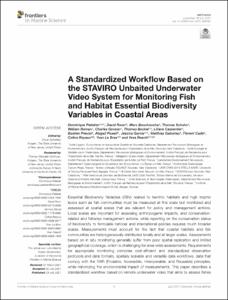| dc.contributor.author | Pelletier, Dominique | |
| dc.contributor.author | Cadé, Florent | |
| dc.contributor.author | Pearlman, Jay | |
| dc.contributor.author | Lara-Lopez, Ana | |
| dc.contributor.author | Roos, David | |
| dc.date.accessioned | 2022-05-31T09:18:41Z | |
| dc.date.available | 2022-05-31T09:18:41Z | |
| dc.date.issued | 2022 | |
| dc.identifier.citation | Pelletier, Dominique, Cadé, Florent, Pearlman, Jay, Lara-Lopez. Ana and Roos David (2022) Best practices for implementing the STAVIRO underwater video protocol. Brest, France, French Institute for the Exploitation of the Sea (Ifremer) and Oceans.mov and Ocean Best Practices System, 07.08 mins [Video mp4]. DOI: http://dx.doi.org/10.25607/OBP-1755 | en_US |
| dc.identifier.uri | https://repository.oceanbestpractices.org/handle/11329/1939 | |
| dc.identifier.uri | http://dx.doi.org/10.25607/OBP-1755 | |
| dc.description.abstract | Essential Biodiversity variables (EBV) related to benthic habitats and high trophic levels such as fish communities must be measured at fine scale but monitored and assessed at spatial scales that are relevant for policy and management actions. Local scales, such as individual marine parks, are important for assessing anthropogenic impacts, and conservation-related and fisheries management actions, while reporting on the conservation status of biodiversity to formulate national and international policies requires much broader scales. Measurements must account for the fact that coastal habitats and fish communities are heterogeneously distributed locally and at larger scales. Assessments based on in situ monitoring generally suffer from poor spatial replication and limited geographical coverage, which is challenging for area-wide assessments. Requirements for appropriate monitoring comprise cost-efficient and standardized observation protocols and data formats, spatially-scalable and versatile data workflows, data that comply with the FAIR (Findable, Accessible, Interoperable and Reusable) principles, while minimizing the environmental impact of measurements. This panoramic unbaited video technique was developed in 2007 to survey both fishes and benthic habitats in a cost-efficient manner, and with minimal effect on biodiversity. It can be deployed in areas where low underwater visibility is not a permanent or major limitation. The technique was consolidated and standardized and has been successfully used in varied settings over the last twelve years. We operationalized the EBV workflow by documenting the field protocol, survey design, image post-processing, EBV production and data curation. The STAVIRO’s proven track-record of utility and cost-effectiveness indicates that it should be considered by other researchers for future applications. | en_US |
| dc.description.sponsorship | EuroSea Project, European Union’s Horizon 2020 research and
innovation programme under grant agreement No. 862626. | |
| dc.language.iso | en | en_US |
| dc.publisher | French Institute for the Exploitation of the Sea (Ifremer) and Oceans.mov and Ocean Best Practices System | en_US |
| dc.rights | Attribution-NonCommercial-ShareAlike 4.0 International | * |
| dc.rights.uri | http://creativecommons.org/licenses/by-nc-sa/4.0/ | * |
| dc.subject.other | STAVIRO (STAtion VIdeo ROtative) | en_US |
| dc.title | Best practices for implementing the STAVIRO underwater video protocol. [VIDEO] | en_US |
| dc.type | Video | en_US |
| dc.description.status | Published | en_US |
| dc.publisher.place | Brest, France | en_US |
| dc.subject.parameterDiscipline | Fish | en_US |
| dc.subject.parameterDiscipline | Underwater photography | en_US |
| dc.subject.parameterDiscipline | Biota abundance, biomass and diversity | en_US |
| dc.subject.instrumentType | underwater cameras | en_US |
| dc.subject.dmProcesses | Data acquisition | en_US |
| dc.subject.dmProcesses | Data analysis | en_US |
| dc.subject.dmProcesses | Data archival/stewardship/curation | en_US |
| dc.subject.dmProcesses | Data visualization | en_US |
| dc.description.currentstatus | Current | en_US |
| dc.description.sdg | 14.a | en_US |
| dc.description.eov | Fish abundance and distribution | en_US |
| dc.description.eov | Hard coral cover and composition | en_US |
| dc.description.eov | Sea grass cover and composition | en_US |
| dc.description.eov | Macroalgal canopy cover and composition | en_US |
| dc.description.eov | Marine turtles, birds, mammals abundance and composition | en_US |
| dc.description.maturitylevel | Mature | en_US |
| dc.description.adoption | Multi-organisational | en_US |
| dc.description.ebv | Taxonomic diversity | en_US |
| dc.description.ebv | Species distribution | en_US |
| dc.description.ebv | Marine habitats | en_US |
| dc.description.sensors | Underwater video lander | en_US |
| dc.description.methodologyType | Method | en_US |
| dc.description.methodologyType | Training/Educational material | en_US |
| obps.endorsementAuthorDeclared.recommendedPractice | Ifremer | |
| obps.contact.contactname | Dominique Pelletier | |
| obps.contact.contactemail | dominique.pelletier@ifremer.fr | |
 Repository of community practices in Ocean Research, Applications and Data/Information Management
Repository of community practices in Ocean Research, Applications and Data/Information Management

